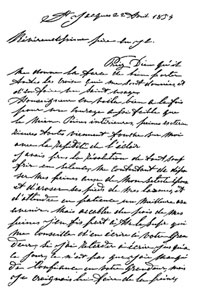






|
|
A prophet for her times, dispossessed by the clerical patriarchy
The foundress of a teaching order, it was in the religious arena that Esther Blondin would encounter opposition.
Mixed schools
 The first resistance Esther met from Church authorities had to do with her firm intention to open mixed schools. Imagine that! An innovative project in favour of poor illiterate children was less important than Church discipline and image. But where solidarity with the excluded seemed to flounder, Esther raised the spiritual argument: “I have prayed for a long time and I feel that it is prayer alone that could have given me the strength to present myself here today.” Touché! Nothing better, she sensed, than to appropriate the same language as the institution. Later, learning from reliable sources that “the community can teach children of both sexes only to the age of 10,” Esther did not hesitate to write to Bishop Bourget that she “regarded herself as having missed the mark because it was the poor who have appealed to her zeal and charity.” Could Bishop Bourget’s decision be seen as a restriction on religious sisters teaching in public schools? The Foundress certainly suggested this in her same letter of July 15, 1851: “ … naturally, the Commissioners will not want to employ the Sisters if children cannot attend the schools up to the age indicated by law.” And yet history tells us that, in spite of the interdict, the sisters, for all kinds of reasons and in various circumstances, continued to teach mixed classes. The first resistance Esther met from Church authorities had to do with her firm intention to open mixed schools. Imagine that! An innovative project in favour of poor illiterate children was less important than Church discipline and image. But where solidarity with the excluded seemed to flounder, Esther raised the spiritual argument: “I have prayed for a long time and I feel that it is prayer alone that could have given me the strength to present myself here today.” Touché! Nothing better, she sensed, than to appropriate the same language as the institution. Later, learning from reliable sources that “the community can teach children of both sexes only to the age of 10,” Esther did not hesitate to write to Bishop Bourget that she “regarded herself as having missed the mark because it was the poor who have appealed to her zeal and charity.” Could Bishop Bourget’s decision be seen as a restriction on religious sisters teaching in public schools? The Foundress certainly suggested this in her same letter of July 15, 1851: “ … naturally, the Commissioners will not want to employ the Sisters if children cannot attend the schools up to the age indicated by law.” And yet history tells us that, in spite of the interdict, the sisters, for all kinds of reasons and in various circumstances, continued to teach mixed classes.
|
|
|